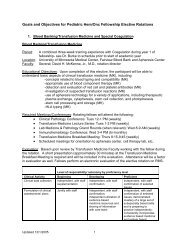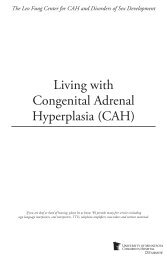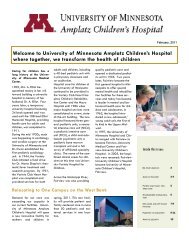Inpatient DKA Protocol - Department of Pediatrics - University of ...
Inpatient DKA Protocol - Department of Pediatrics - University of ...
Inpatient DKA Protocol - Department of Pediatrics - University of ...
Create successful ePaper yourself
Turn your PDF publications into a flip-book with our unique Google optimized e-Paper software.
GUIDELINES FOR THE TREATMENT OF PEDIATRICDIABETIC KETOACIDOSISprepared by Toni Moran MD, 3/97revised by Toni Moran and Chris Ternand 3/02 and Toni Moran 4/03These standards were developed by members <strong>of</strong> the Metropolitan Community PediatricEndocrinology Registry, including David M. Brown MD, Erica Eugster MD, Antoinette MoranMD, Kumud Sane MD, Kevin Sheridan MD, Joseph Sockalosky MD, Martha Spencer MD, andChristine Ternand MD. They are meant to provide a protocol for the usual treatment <strong>of</strong> <strong>DKA</strong>---clinical judgement may dictate deviation from these guidelines in individual circumstances.Definition <strong>of</strong> <strong>DKA</strong>:1) venous pH < 7.25 or arterial pH < 7.3; and/or bicarbonate < 15 mEq/L2) and urine or serum ketones positive3) glucose is usually but not always > 200 mg/dlGoals <strong>of</strong> therapy:1) hydration3) correction <strong>of</strong> acid/base abnormality2) clearance <strong>of</strong> ketones4) normalization <strong>of</strong> blood glucose level5) correction <strong>of</strong> electrolyte abnormalities, particularly potassium depletion6) prevention <strong>of</strong> future episodesIn ER or <strong>of</strong>fice:1) H and P (occult infection?), rapid glucose determination, check urine <strong>of</strong> blood for ketones2) Place 2 IV's---at least one should be large enough to draw blood samples from.3) Start 20 cc/kg NS flush to run over 1 hour.4) Get STAT Glucose, Na, K, Cl, bicarb, BUN, creat, phos, VBG.5) Cardiac rhythm strip if K>6.0 or
3. age less than 3 years4. if 1:2 nursing care is not available on general wards while patient is on insulindrip5. shock, cardiac arrhythmias, EKG changes associated with hyper- orhypokalemia6. recommendation <strong>of</strong> pediatric endocrinologistb. Otherwise, admit to hospital wards or equivalent facility where patient is under directobservation and receiving 1:1 or 1:2 nursing care.c. Pediatric endocrinology should be involved from the beginning in all pediatric <strong>DKA</strong>admissions, either as the primary service or as consultants.After initial hydration with 20 cc/kg saline flush:Fluids (assume at least 10% dehydration):1). If patient has good urine output and is not hyperkalemic, start D5W1/2 NS + KCl (or anequivalent solution). Otherwise, give a second 20cc/kg NS flush and then switch toD5W1/2NS.a. Guidelines for the initial potassium rate (which will need to be modified duringtreatment based on ongoing K measurement):1. If K 5.5, no K in iv4. Some protocols give half <strong>of</strong> the potassium concentration as KPhos.*The inclusion <strong>of</strong> D5W from the start <strong>of</strong> treatment is not typical <strong>of</strong> most <strong>DKA</strong> protocolsbut we feel that this allows for a more gradual fall in blood glucose levels and circumventssome <strong>of</strong> the problems which occur when glucose is not added to the iv soon enough.2) Calculate the maintenance+deficit and plan to replace this amount evenly over 36 hrs,recognizing that most patients will not receive the full amount.a. Alternatively, give 2x maintenance, generally not more than 3000cc/m 2 per 24h.3) When the serum glucose approaches 300 mg/dl or if the glucose is falling at a rate greaterthan 100 mg/dl/hour after the initial drop from the fluid flush, change the dextrose content <strong>of</strong>the iv fluids to D10W.4) Monitor strict I/Os---re-evaluate fluid status frequently.5) Have the nurses keep a diabetic flowsheet.6) NPO until alert and not vomiting, then small amounts non-carbohydrate containing clearfluids; advance diet as tolerated. No oral carbohydrates until subcutaneous insulin is started.2<strong>University</strong> <strong>of</strong> Minnesota<strong>Department</strong> <strong>of</strong> <strong>Pediatrics</strong> Division <strong>of</strong> EndocrinologyPhone 612-624-5409
Insulin:1) After the fluid flush, start an insulin drip <strong>of</strong> 0.1 U/kg/hr (no bolus necessary).a. If
Switching to subcutaneous insulin:Please discuss with a pediatric endocrinologist the plan for starting subcutaneous insulin.The iv insulin should never be discontinued until subcutaneous insulin ahs been given.EducationIn newly diagnosed patients, education <strong>of</strong> the patient and family with diabetes survivalskills is essential following correction <strong>of</strong> the <strong>DKA</strong>. This can be done in the hospital or as anoutpatient if the patient is seen as an outpatient that day.Discharge1) Prior to discharge address the underlying cause <strong>of</strong> <strong>DKA</strong>. If it appears to bepsychosocial, involve the appropriate mental health care pr<strong>of</strong>essionals.2). Before going home, the patient and family must know:a. who they are to be in close contact with during the initial period <strong>of</strong> insulinadjustment and outpatient diabetes education, and when they are to return toclinic---they must be seen within 72 hours if they have received the educationlisted below in the hospital, or that day in clinic if that is where the initialeducation is to be given. They must be in daily phone contact with their diabetesprovider the first week after discharge.b. how to use a glucose monitoring devise to check blood glucose levelsc. how to draw up insulin and give injectionsd. how to recognize and treat hypoglycemia, including administration <strong>of</strong> glucagone. the basic principles <strong>of</strong> diet in terms <strong>of</strong> both content and timing <strong>of</strong> meals and snacks4<strong>University</strong> <strong>of</strong> Minnesota<strong>Department</strong> <strong>of</strong> <strong>Pediatrics</strong> Division <strong>of</strong> EndocrinologyPhone 612-624-5409






